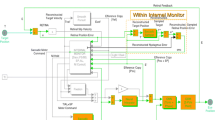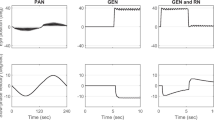Abstract.
Spontaneous sinusoidal oscillations of the eyes are a feature of disorders affecting central myelin, including multiple sclerosis. The mechanism responsible for these oscillations (pendular nystagmus) is unknown. We tested the hypothesis that pendular nystagmus is due to instability of the neural integrator, a network of neurons that normally guarantees steady gaze by mathematically integrating premotor signals. It was possible to make a model of the neural integrator unstable, and abnormal feedback then produced sustained oscillations so that it simulated pendular nystagmus. One prediction of the model is that a large premotor signal, such as is required to generate a rapid (saccadic) eye movement, will transiently suppress the activity of some neurons in the network, and that this will "reset" the oscillations, i.e., produce a phase shift; larger saccades will produce greater phase shifts. Alternatively, if the source of pendular nystagmus is outside the neural integrator (i.e., is present on velocity inputs to the stable integrator), then it may not be possible to reset the oscillations with a saccadic eye movement. We compared the phase relationships of pendular nystagmus prior to and following saccades in six patients with multiple sclerosis (MS). All patients showed phase shifts (median 64°) of their ocular oscillations following large (more than 10°) saccades; smaller saccades (less than 5°) caused smaller phase shifts (median 17°). Our findings suggest that, in MS, pendular nystagmus arises from an instability in the feedback control of the neural integrator for eye movements, which depends on a distributed network of neurons in the brainstem and cerebellum.
Similar content being viewed by others
Author information
Authors and Affiliations
Additional information
Electronic Publication
Rights and permissions
About this article
Cite this article
Das, V., Oruganti, P., Kramer, P. et al. Experimental tests of a neural-network model for ocular oscillations caused by disease of central myelin. Exp Brain Res 133, 189–197 (2000). https://doi.org/10.1007/s002210000367
Received:
Accepted:
Issue Date:
DOI: https://doi.org/10.1007/s002210000367




